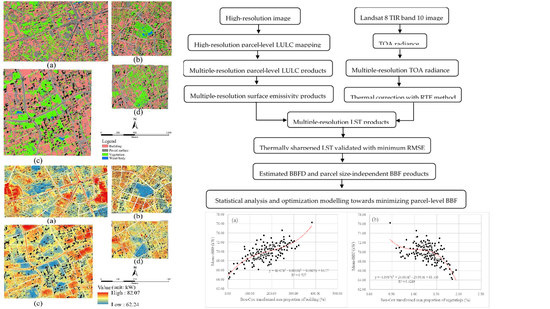Understanding the Role of Optimized Land Use/Land Cover Components in Mitigating Summertime Intra-Surface Urban Heat Island Effect: A Study on Downtown Shanghai, China
Abstract
1. Introduction
2. Location of the Study Area
3. Materials and Methods
3.1. Materials
3.2. Methods
3.2.1. Classification of LULC Components and Delimitation of Land Parcels
3.2.2. Retrieval and Validation of High-Resolution Thermally Sharpened LST
3.2.3. Estimation of Parcel-Level Sensible Heat Flux
3.2.4. Statistical Analysis and Estimating the Optimized Lulc Components for Minimizing Mean_pc_BBF
4. Results
4.1. Synoptic Analysis of Parcel-level LULC Components and Mean_pc_BBF
4.2. Interpretation of Relationship between Parcel-Level LULC Components and Mean_pc_BBF
4.3. Comparison of the Present and Optimized Parcel-level LULC Components and the Associated Mean_pc_BBF
5. Discussion
5.1. On the Data, Methods, and Findings of this Study
5.2. Implications for Practical Solutions to Optimized Parcel-Level LULC Components towards Mitigating Intra-SUHI Effect
5.3. Limitation of this Study and Future Researching Tasks
6. Conclusions
Author Contributions
Funding
Acknowledgments
Conflicts of Interest
Appendix A
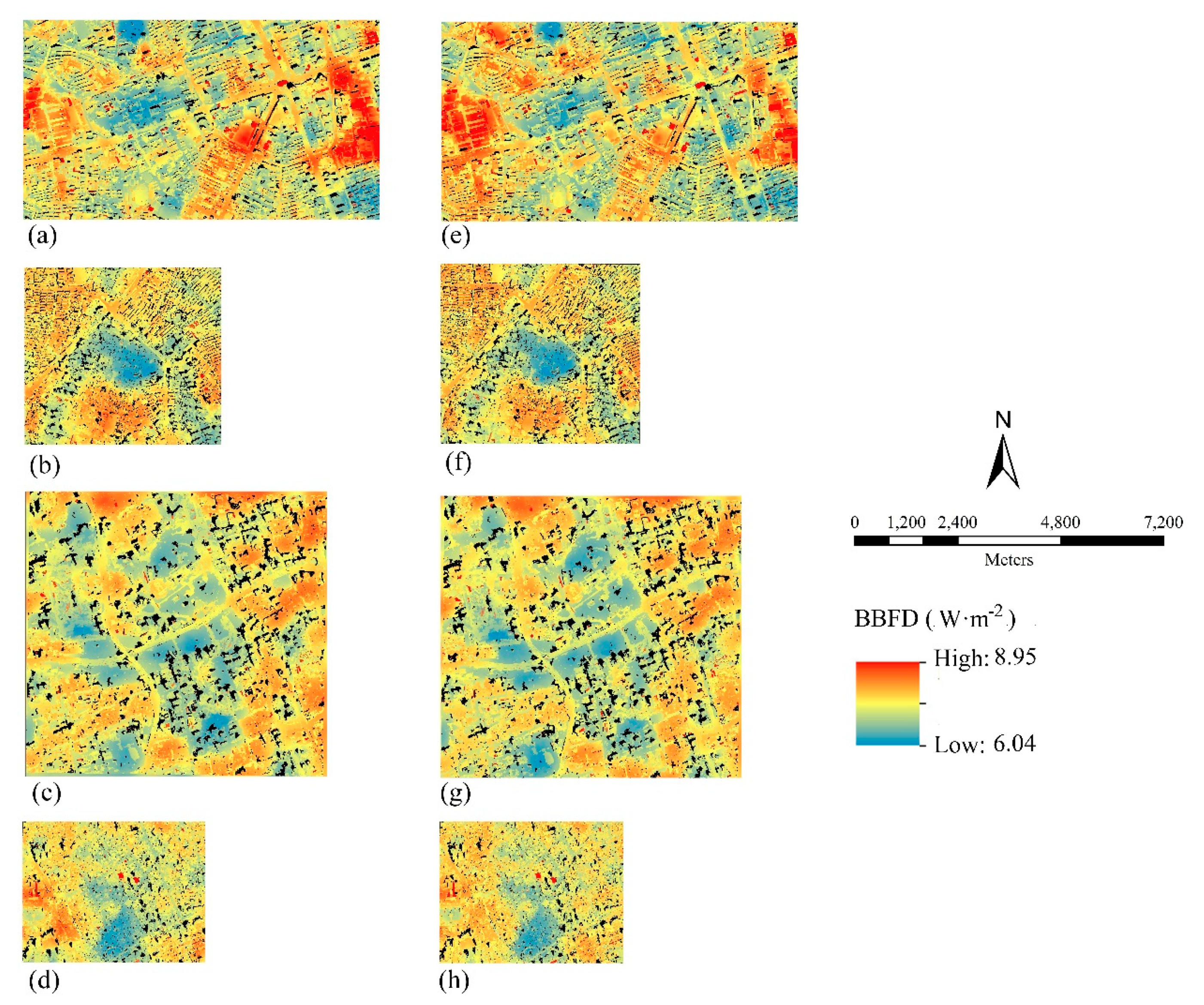
| 1m | 3m | 5m | 7m | 9m | |
|---|---|---|---|---|---|
| Mean ± s.d. | 2.51 ± 0.32a | 2.71 ± 0.33a | 2.83 ± 0.42a,b | 2.90 ± 0.56a,b | 3.20 ± 0.65 b |
| Box-Cox Transformed | Estimated Lambda (λ) | Formulas |
|---|---|---|
| X1 | 0.50 | X1 = sqrt (Paved surface) |
| X2 | 0.11 | |
| X3 | 0.00 | X3 = log (Vegetation) |
| X4 | 1.34 |
References
- United Nations. 2018 Revision of World Urbanization Prospects. Available online: https://www.un.org/development/desa/publications/2018-revision-of-world-urbanization-prospects.html (accessed on 20 November 2019).
- Luck, M.; Wu, J. A gradient analysis of urban landscape pattern: A case study from the Phoenix metropolitan region, Arizona, USA. Landsc. Ecol. 2002, 17, 327–339. [Google Scholar] [CrossRef]
- Li, J.; Song, C.; Cao, L.; Zhu, F.; Meng, X.; Wu, J. Impacts of landscape structure on surface urban heat islands: A case study of Shanghai, China. Remote Sens. Environ. 2011, 115, 3249–3263. [Google Scholar] [CrossRef]
- Cai, Y.-B.; Li, H.-M.; Ye, X.-Y.; Zhang, H. Analyzing Three-Decadal Patterns of Land Use/Land Cover Change and Regional Ecosystem Services at the Landscape Level: Case Study of Two Coastal Metropolitan Regions, Eastern China. Sustainability 2016, 8, 773. [Google Scholar] [CrossRef]
- Clerici, N.; Cote-Navarro, F.; Escobedo, F.J.; Rubiano, K.; Villegas, J.C. Spatio-temporal and cumulative effects of land use-land cover and climate change on two ecosystem services in the Colombian Andes. Sci. Total Environ. 2019, 10, 1181–1192. [Google Scholar] [CrossRef] [PubMed]
- Dewan, A.M.; Yamaguchi, Y. Land use and land cover change in Greater Dhaka, Bangladesh: Using remote sensing to promote sustainable urbanization. Appl. Geogr. 2009, 29, 390–401. [Google Scholar] [CrossRef]
- King, R.S.; Scoggins, M.; Porras, A. Stream biodiversity is disproportionately lost to urbanization when flow permanence declines: Evidence from southwestern North America. Freshw. Sci. 2016, 35, 340–352. [Google Scholar] [CrossRef]
- Nguyen, H.H.; Recknagel, F.; Meyer, W. Effects of projected urbanization and climate change on flow and nutrient loads of a Mediterranean catchment in South Australia. Ecohydrol. Hydrobiol. 2019, 19, 279–288. [Google Scholar] [CrossRef]
- Pickard, B.R.; Van Berkel, D.; Petrasova, A.; Meentemeyer, R.K. Forecasts of urbanization scenarios reveal trade-offs between landscape change and ecosystem services. Landsc. Ecol. 2016, 32, 617–634. [Google Scholar] [CrossRef]
- Mati, B.M.; Mutie, S.; Gadain, H.; Home, P.; Mtalo, F. Impacts of land-use/cover changes on the hydrology of the transboundary Mara River, Kenya/Tanzania. Lakes Reserv. Res. Manag. 2008, 13, 169–177. [Google Scholar] [CrossRef]
- Reyers, B.; O’Farrell, P.J.; Cowling, R.M.; Egoh, B.N.; Le Maitre, D.C.; Vlok, J.H.J. Ecosystem services, land-cover change, and stakeholders: Finding a sustainable foothold for a semiarid biodiversity hotspot. Ecol. Soc. 2009, 14, 38. [Google Scholar] [CrossRef]
- McMichael, A.J.; Woodruff, R.E.; Hales, S. Climate change and human health: Present and future risks. Lancet 2006, 367, 859–869. [Google Scholar] [CrossRef]
- Jenerette, G.D.; Harlan, S.L.; Buyantuev, A.; Stefanov, W.L.; Declet-Barreto, J.; Ruddell, B.L.; Myint, S.W.; Kaplan, S.; Li, X. Micro-scale urban surface temperatures are related to land-cover features and residential heat related health impacts in Phoenix, AZ USA. Landsc. Ecol. 2016, 31, 745–760. [Google Scholar] [CrossRef]
- Chen, Y.; Cai, Y.; Tong, C. Quantitative analysis of urban cold island effects on the evolution of green spaces in a coastal city: A case study of Fuzhou, China. Environ. Monit. Assess. 2019, 191, 121. [Google Scholar] [CrossRef] [PubMed]
- Conlon, K.; Monaghan, A.; Hayden, M.; Wilhelmi, O. Potential Impacts of Future Warming and Land Use Changes on Intra-Urban Heat Exposure in Houston, Texas. PLoS ONE 2016, 11. [Google Scholar] [CrossRef]
- Huang, Q.; Lu, Y. The Effect of Urban Heat Island on Climate Warming in the Yangtze River Delta Urban Agglomeration in China. Int. J. Environ. Res. Public Health 2015, 12, 8773–8789. [Google Scholar] [CrossRef]
- Morabito, M.; Crisci, A.; Georgiadis, T.; Orlandini, S.; Munafò, M.; Congedo, L.; Rota, P.; Zazzi, M. Urban Imperviousness Effects on Summer Surface Temperatures Nearby Residential Buildings in Different Urban Zones of Parma. Remote Sens. 2018, 10, 26. [Google Scholar] [CrossRef]
- Trlica, A.; Hutyra, L.R.; Schaaf, C.L.; Erb, A.; Wang, J.A. Albedo, Land Cover, and Daytime Surface Temperature Variation Across an Urbanized Landscape. Earth Future 2017, 5, 1084–1101. [Google Scholar] [CrossRef]
- Turner, B.L., II. Land system architecture for urban sustainability: New directions for land system science illustrated by application to the urban heat island problem. J. Land Use Sci. 2016, 11, 689–697. [Google Scholar] [CrossRef]
- Harlan, S.L.; Ruddell, D.M. Climate change and health in cities: Impacts of heat and air pollution and potential co-benefits from mitigation and adaptation. Curr. Opin. Env. Sust. 2011, 3, 126–134. [Google Scholar] [CrossRef]
- Li, D.; Bou-Zeid, E. Synergistic Interactions between Urban Heat Islands and Heat Waves: The Impact in Cities Is Larger than the Sum of Its Parts. Meteorol. Clim. 2013, 52, 2051–2064. [Google Scholar] [CrossRef]
- Tan, J.; Zheng, Y.; Tang, X.; Guo, C.; Li, L.; Song, G.; Zhen, X.; Yuan, D.; Kalkstein, A.J.; Li, F. The urban heat island and its impact on heat waves and human health in Shanghai. Int. J. Biometeorol. 2010, 54, 75–84. [Google Scholar] [CrossRef] [PubMed]
- Stewart, I.D.; Oke, T.R. Local Climate Zones for Urban Temperature Studies. B Am. Meteorol. Soc. 2012, 93, 1879–1900. [Google Scholar] [CrossRef]
- Yang, Y.J.; Wu, B.W.; Shi, C.E.; Zhang, J.H.; Li, Y.B.; Tang, W.A.; Wen, H.Y.; Zhang, H.Q.; Shi, T. Impacts of urbanization and station-relocation on surface air temperature series in Anhui Province, China. Pure Appl. Geophys. 2013, 170, 1969–1983. [Google Scholar] [CrossRef]
- Benas, N.; Chrysoulakis, N.; Cartalis, C. Trends of urban surface temperature and heat island characteristics in the Mediterranean. Theor. Appl. Climatol. 2017, 130, 807–816. [Google Scholar] [CrossRef]
- Weng, Q. Thermal infrared remote sensing for urban climate and environmental studies: Methods, applications, and trends. ISPRS J. Photogramm. Remote Sens. 2009, 64, 335–344. [Google Scholar] [CrossRef]
- Bonafoni, S.; Anniballe, R.; Gioli, B.; Toscano, P. Downscaling Landsat Land Surface Temperature over the urban area of Florence. Eur. J. Remote Sens. 2016, 49, 553–569. [Google Scholar] [CrossRef]
- Holderness, T.; Barr, S.; Dawson, R.; Hall, J. An evaluation of thermal Earth observation for characterizing urban heatwave event dynamics using the urban heat island intensity metric. Int. J. Remote Sens. 2013, 34, 864–884. [Google Scholar] [CrossRef]
- Streutker, D. Satellite-measured growth of the urban heat island of Houston, Texas. Remote Sens. Environ. 2003, 85, 282–289. [Google Scholar] [CrossRef]
- Baldinelli, G.; Bonafoni, S.; Anniballe, R.; Presciutti, A.; Gioli, B.; Magliulo, V. Spaceborne detection of roof and impervious surface albedo: Potentialities and comparison with airborne thermography measurements. Solar Energy 2016, 49, 553–569. [Google Scholar] [CrossRef]
- Zhang, H.; Jing, X.-M.; Chen, J.-Y.; Li, J.-J.; Schwegler, B. Characterizing Urban Fabric Properties and Their Thermal Effect Using QuickBird Image and Landsat 8 Thermal Infrared (TIR) Data: The Case of Downtown Shanghai, China. Remote Sens. 2016, 8, 541. [Google Scholar] [CrossRef]
- Stone, B.; Norman, J.M. Land use planning and surface heat island formation: A parcel-based radiation flux approach. Atmos. Environ. 2006, 40, 3561–3573. [Google Scholar] [CrossRef]
- Georgescu, M.; Morefield, P.E.; Bierwagen, B.G.; Weaver, C.P. Urban adaptation can roll back warming of emerging megapolitan regions. Proc. Natl. Acad. Sci. USA 2014, 111, 2909–2914. [Google Scholar] [CrossRef] [PubMed]
- Liu, J.; Shao, Q.; Yan, X.; Fan, J.; Zhan, J.; Deng, X.; Kuang, W.; Huang, L. The climatic impacts of land use and land cover change compared among countries. J. Geogr. Sci. 2016, 26, 889–903. [Google Scholar] [CrossRef]
- Peng, J.; Jia, J.; Liu, Y.; Li, H.; Wu, J. Seasonal contrast of the dominant factors for spatial distribution of land surface temperature in urban areas. Remote Sens. Environ. 2018, 215, 255–267. [Google Scholar] [CrossRef]
- Li, F.; Liu, X.; Zhang, X.; Zhao, D.; Liu, H.; Zhou, C.; Wang, R. Urban ecological infrastructure: An integrated network for ecosystem services and sustainable urban systems. J. Clean Prod. 2017, 163, S12–S18. [Google Scholar] [CrossRef]
- Dissanayake, D.; Morimoto, T.; Murayama, Y.; Ranagalage, M. Impact of Landscape Structure on the Variation of Land Surface Temperature in Sub-Saharan Region: A Case Study of Addis Ababa using Landsat Data (1986–2016). Sustainability 2019, 11, 2257. [Google Scholar] [CrossRef]
- Daily, G. Nature’s Services: Societal Dependence on Natural Ecosystems; Island Press: Washington, DC, USA, 1997. [Google Scholar]
- Gill, S.; Handley, J.; Ennos, A.; Pauleit, S. Adapting Cities for Climate Change: The Role of the Green Infrastructure. Built. Environ. 2007, 33, 115–133. [Google Scholar] [CrossRef]
- Polydoros, A.; Mavrakou, T.; Cartalis, C. Quantifying the Trends in Land Surface Temperature and Surface Urban Heat Island Intensity in Mediterranean Cities in View of Smart Urbanization. Urban Sci. 2018, 2, 16. [Google Scholar] [CrossRef]
- Shanghai Municipal Statistics Bureau (SMSB); Survey Office of the National Bureau of Statistics in Shanghai (SONBS-SH). Shanghai Statistical Yearbook-2018; China Statistics Press: Beijing, China, 2018. [Google Scholar]
- Feng, Y.; Du, S.; Myint, S.W.; Shu, M. Do Urban Functional Zones Affect Land Surface Temperature Differently? A Case Study of Beijing, China. Remote Sens. 2019, 11, 1802. [Google Scholar] [CrossRef]
- Huang, X.; Wang, Y. Investigating the effects of 3D urban morphology on the surface urban heat island effect in urban functional zones by using high-resolution remote sensing data: A case study of Wuhan, Central China. ISPRS J. Photogramm. 2019, 152, 119–131. [Google Scholar] [CrossRef]
- Song, J.; Lin, T.; Li, X.; Prishchepov, A.V. Mapping urban functional zones by integrating very high spatial resolution remote sensing imagery and points of interest: A case study of Xiamen, China. Remote Sens. 2018, 10, 1737. [Google Scholar] [CrossRef]
- Zhang, X.; Du, S.; Wang, Q.; Zhou, W. Multiscale geoscene segmentation for extracting urban functional zones from VHR satellite images. Remote Sens. 2018, 10, 281. [Google Scholar] [CrossRef]
- Beijing Digital Space Technology Co. Ltd. The Standard GIS-Based Altas of Shanghai; Beijing Digital Space Technology Co. Ltd.: Beijing, China, 2015. [Google Scholar]
- Blaschke, T.; Strobl, J. What’s wrong with pixels? Some recent developments interfacing remote sensing and GIS. GIS–Z. Geoinform. Syst. 2001, 14, 12–17. [Google Scholar]
- Hamedianfar, A.; Shafri, H.Z.M. Development of fuzzy rule-based parameters for urban object-oriented classification using very high resolution imagery. Geocarto Int. 2014, 29, 268–292. [Google Scholar] [CrossRef]
- Mathieu, R.; Freeman, C.; Aryal, J. Mapping private gardens in urban areas using object-oriented techniques and very high-resolution satellite imagery. Landsc. Urban Plan. 2007, 81, 179–192. [Google Scholar] [CrossRef]
- Su, W.; Zhang, C.; Yang, J.; Wu, H.; Deng, L.; Ou, W.; Yue, A.; Chen, M. Analysis of wavelet packet and statistical textures for object-oriented classification of forest-agriculture ecotones using SPOT 5 imagery. Int. J. Remote Sens. 2012, 33, 3557–3579. [Google Scholar] [CrossRef]
- Malaret, E.; Bartolucci, L.A.; Lozano, D.F.; Anuta, P.E.; McGillem, C.D. Landsat-4 and Landsat-5 Thematic Mapper data quality analysis. Photogramm. Eng. Rem. S. 1985, 51, 1407–1416. [Google Scholar]
- Barsi, J.; Schott, J.; Hook, S.; Raqueno, N.; Markham, B.; Radocinski, R. Landsat-8 Thermal Infrared Sensor (TIRS) Vicarious Radiometric Calibration. Remote Sens. 2014, 6, 11607–11626. [Google Scholar] [CrossRef]
- U.S. Department of the Interior (USDOI). U.S. Geological Survey (USGS). Landsat 8 (L8) Data Users Handbook (Version 1.0); EROS: Sioux Falls, SD, USA, 2015.
- Nichol, E.J. High-Resolution Surface Temperature Patterns Related to Urban Morphology in a Tropical City: A Satellite-Based Study. J. Appl. Meteorol. 1996, 35, 135–146. [Google Scholar] [CrossRef]
- Weng, Q.; Lu, D.; Schubring, J. Estimation of land surface temperature–vegetation abundance relationship for urban heat island studies. Remote Sens. Environ. 2004, 89, 467–483. [Google Scholar] [CrossRef]
- Uni-Trend Inc. The UNI-T® User Guidance Version 1.08.14s; Uni-Trend Inc.: Shenzhen, China, 2014. [Google Scholar]
- Jiménez-Muñoz, J.C.; Sobrino, J.A. A generalized single-channel method for retrieving land surface temperature from remote sensing data. J. Geophys. Res. Atmos. 2003, 108, 4688. [Google Scholar] [CrossRef]
- NASA. Atmospheric Correction Parameter Calculator. Available online: http://atmcorr.gsfc.nasa.gov/ (accessed on 1 November 2019).
- R Core Team. R: A Language and Environment for Statistical Computing; R Foundation for Statistical Computing: Vienna, Austria, 2019. [Google Scholar]
- Bjørn-Helge Mevik and Ron Wehrens. The pls package: Principal component and partialleast squares regression in R. J. Stat. Softw. 2007, 18, 1–24. [Google Scholar]
- Ghalanos, A.; Theussl, S. Rsolnp: General Non-Linear Optimization Using Augmented Lagrange Multiplier Method. R Package Version 1.16; R Foundation for Statistical Computing: Vienna, Austria, 2015. [Google Scholar]
- Kim, J.H.; Gu, D.; Sohn, W.; Kil, S.H.; Kim, H.; Lee, D.K. Neighborhood Landscape Spatial Patterns and Land Surface Temperature: An Empirical Study on Single-Family Residential Areas in Austin, Texas. Int. J. Environ. Re.s Public Health 2016, 13, 880. [Google Scholar] [CrossRef] [PubMed]
- Wong, M.S.; Nichol, J.E.; To, P.H.; Wang, J. A simple method for designation of urban ventilation corridors and its application to urban heat island analysis. Build Environ. 2010, 45, 1880–1889. [Google Scholar] [CrossRef]
- Connors, J.P.; Galletti, C.S.; Chow, W.T.L. Landscape configuration and urban heat island effects: Assessing the relationship between landscape characteristics and land surface temperature in Phoenix, Arizona. Landsc. Ecol. 2012, 28, 271–283. [Google Scholar] [CrossRef]
- Zhou, W.; Cao, F.; Wang, G. Effects of Spatial Pattern of Forest Vegetation on Urban Cooling in a Compact Megacity. Forests 2019, 10, 282. [Google Scholar] [CrossRef]
- Zhang, S.-Y. Green Space System Planning in Shanghai. Urban Plan Forum 2002, 6, 14–16. [Google Scholar]
- Cheng, J.; Yang, K.; Zhao, J.; Yuan, W.; Wu, J.-P. Variation of river system in center district of Shanghai and its impact factors during the last one hundred years. Sci. Geogr. Sinica 2007, 27, 85–91. [Google Scholar]
- Wang, H.-J. Application of drainage mode in urban diked area: A new mode for urban drainage. Shanghai Water 2001, 2, 37–39. [Google Scholar]
- Zhou, Z.-H. Shanghai Historical Atlas; Shanghai People’s Publishing House: Shanghai, China, 1999. [Google Scholar]
- Zhou, H.-M.; Gao, Y.; Ge, W.-Q.; Li, T.-T. The Research on the Relationship Between the Urban Expansion and the Change of the Urban Heat Island Distribution in Shanghai Area. Ecol Environ. 2008, 17, 163–168. [Google Scholar]
- Zhang, H.; Qi, Z.-F.; Ye, X.-Y.; Cai, Y.-B.; Ma, W.-C.; Chen, M.-N. Analysis of land use/land cover change, population shift, and their effects on spatiotemporal patterns of urban heat islands in metropolitan shanghai, china. Appl. Geogr. 2013, 44, 121–133. [Google Scholar] [CrossRef]
- Shanghai Forestry Bureau (SFB). Revisiting the Past 40-Year Environment in Shanghai. Available online: http://lhsr.sh.gov.cn/sites/ShanghaiGreen/dyn/ViewCon.ashx?ctgId=5b30d611-d8e6-467f-b36b-edb8a094bcb7&InfId=ffd2dbcd-5e7a-4222-aafb-c567f4ee7ac4 (accessed on 1 March 2019).
- Chakraborty, S.D.; Kant, Y.; Mitra, D. Assessment of land surface temperature and heat fluxes over Delhi using remote sensing data. J. Environ. Manag. 2015, 148, 143–152. [Google Scholar] [CrossRef] [PubMed]
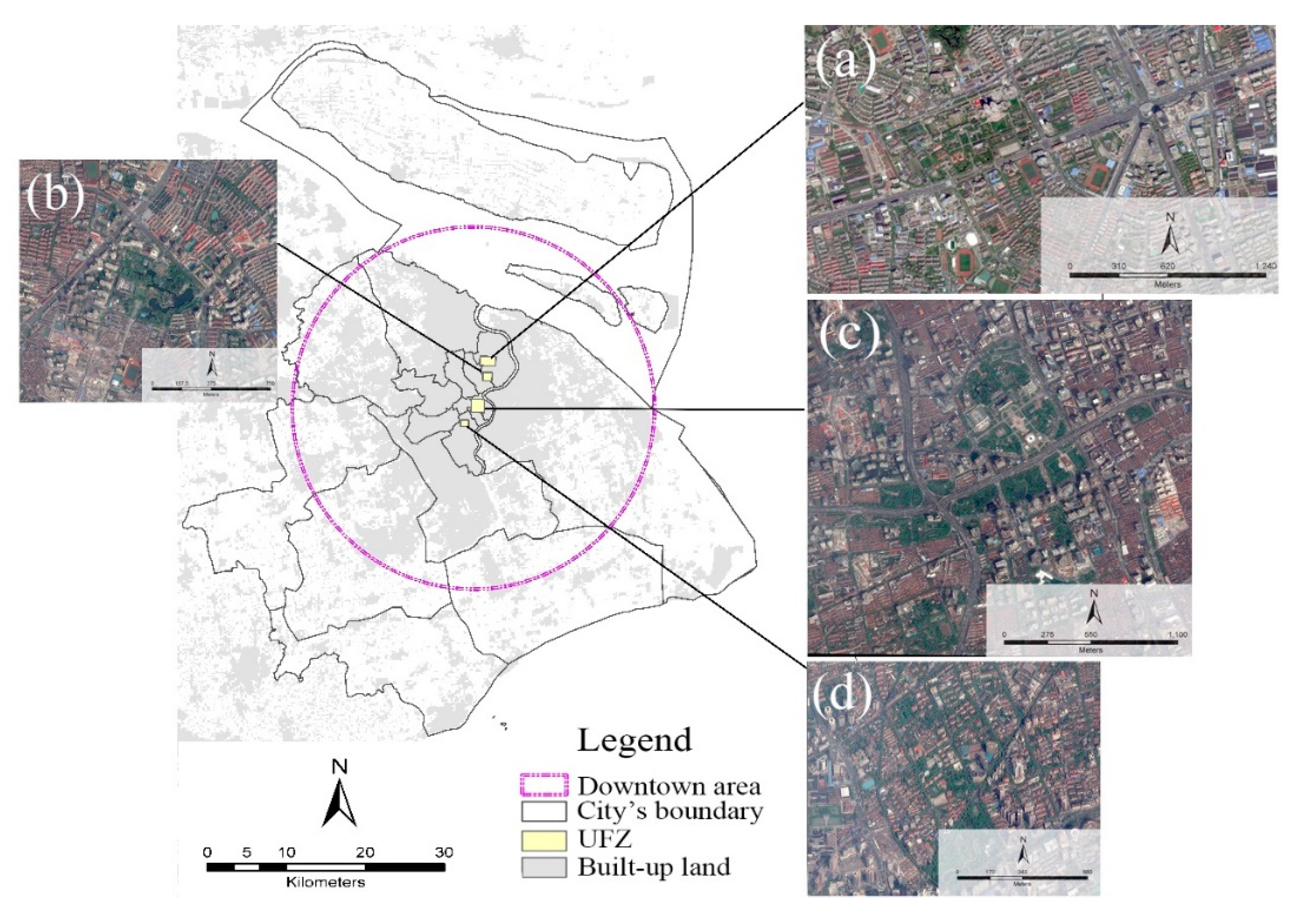
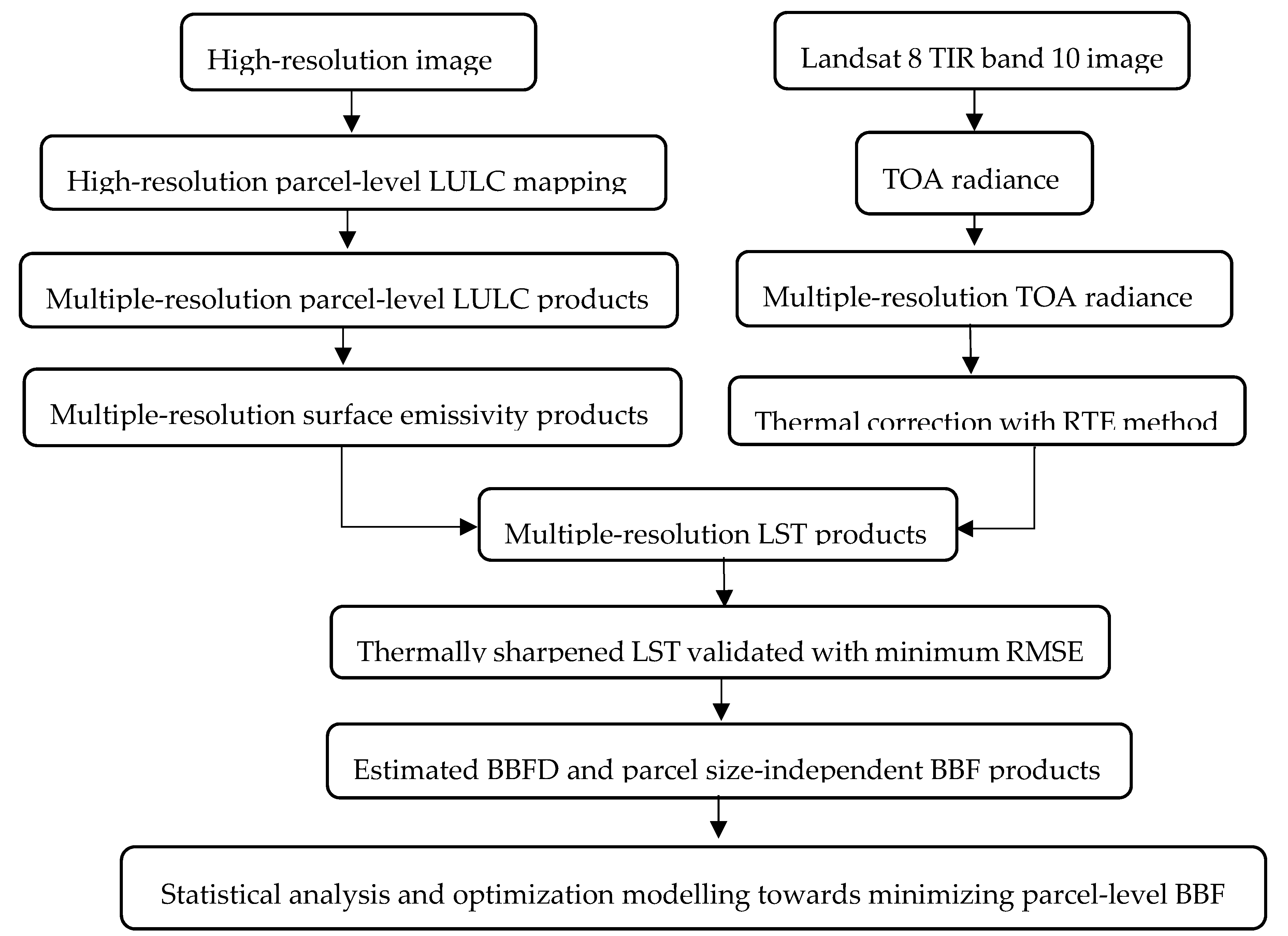
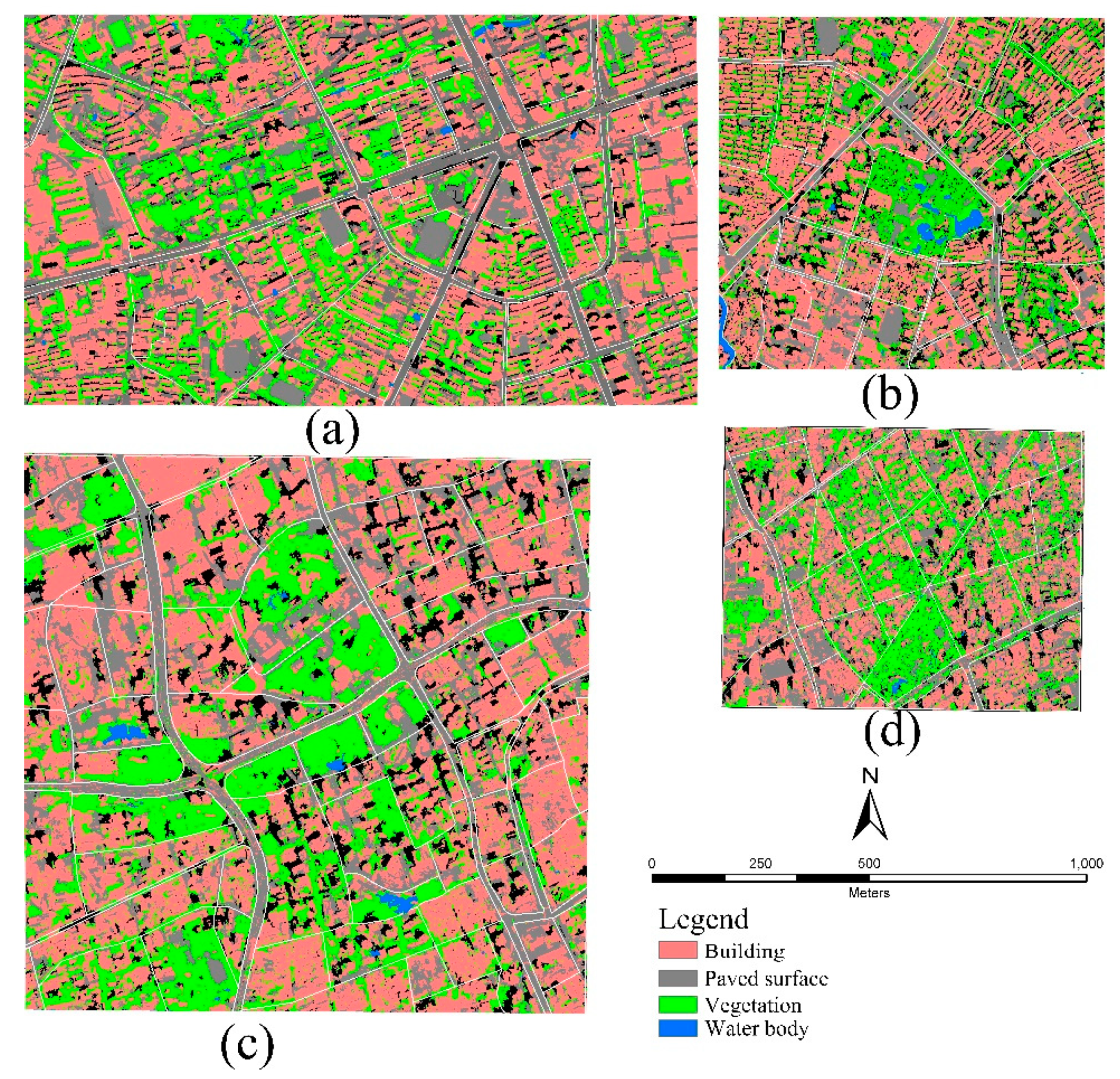
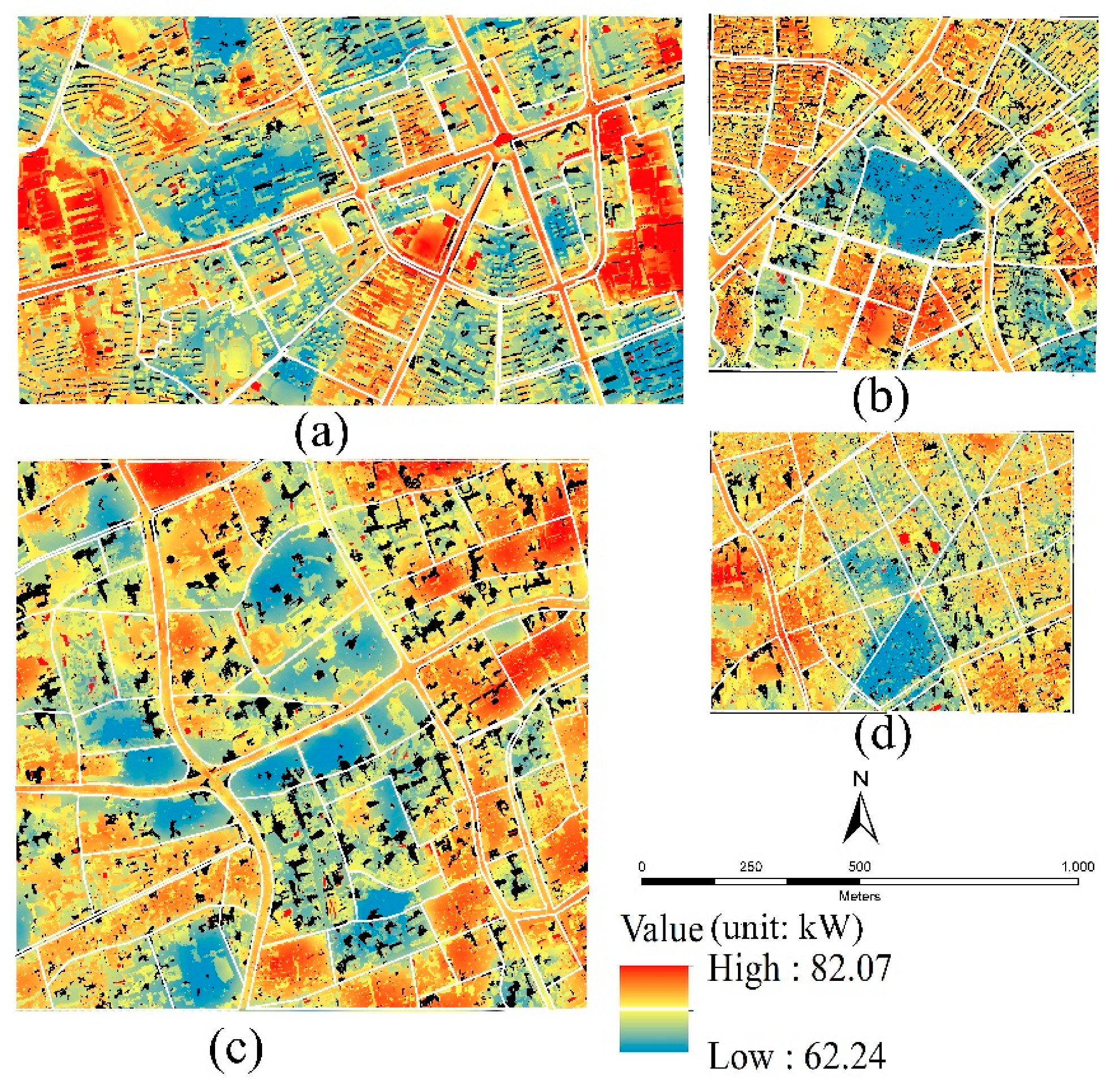
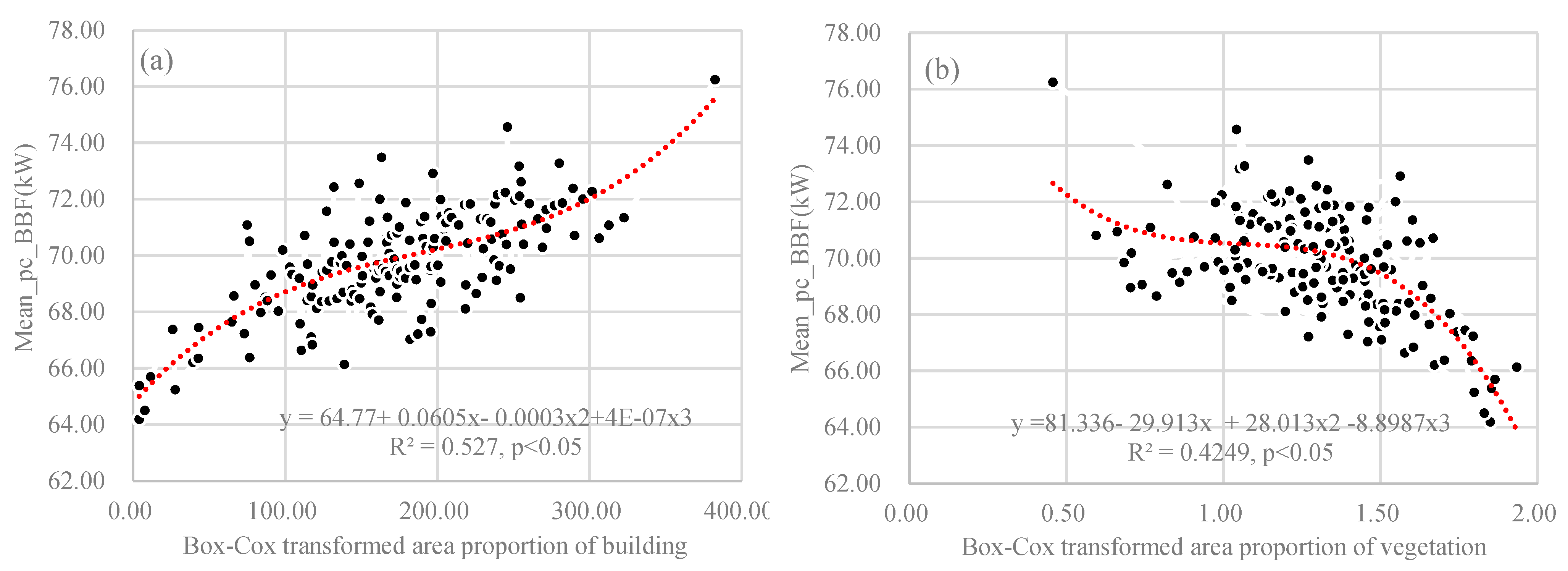
| UFZ | Area (km2) | Description |
|---|---|---|
| Wujiaochang | 7.09 | One of the subcenters of downtown Shanghai with a cluster featuring a commercial center, colleges and universities, and a high-tech park for innovative firms. |
| PeacePark | 2.00 | Featured with a cluster of high education, innovative enterprises, Peace park, and recreational landscaping. |
| UrbanCore | 5.97 | The heart of downtown Shanghai, with a cluster of municipal administrative services, banking, headquarter economy, commercial center, and historical and cultural resorts. |
| Xujiahui | 2.58 | One of the sub-centers of downtown Shanghai, featuring a cluster of a commercial center, historical and cultural resorts, high education, advanced medical care, and innovative enterprises. |
| Pairwise | Correlation |
|---|---|
| X2 (Waterbody) vs. X1 (Paved surface) | −0.166* |
| X3 (Vegetation) vs. X1 (Paved surface) | −0.312** |
| X4 (Building) vs. X1 (Paved surface) | −0.194* |
| X3 (Vegetation) vs. X2 (Waterbody) | 0.503** |
| X4 (Building) vs. X2 (Waterbody) | −0.387** |
| X4 (Building) vs. X3 (Vegetation) | −0.611** |
| X1 (Paved surface) vs. Mean_pc_BBF | 0.620** |
| X2 (Waterbody) vs. Mean_pc_BBF | −0.435** |
| X3 (Vegetation) vs. Mean_pc_BBF | −0.470** |
| X4 (Building) vs. Mean_pc_BBF | 0.639** |
| Variable | Coef | S-Coef |
|---|---|---|
| Constant | 64.699 | 0 |
| X1: Paved surface | 0.417 | 0.267 |
| X2: Waterbody | −0.464 | −0.291 |
| X3: Vegetation | 0.562 | 0.085 |
| X4: Building | 0.019 | 0.741 |
| Waterbody × Vegetation | −0.32 | −0.196 |
| Summary statistics | F = 51.340, p < 0.05 | |
| Adjusted R2 = 0.561 | ||
| Area Proportion (%) | Mean_pc_BBF (kW) | |||
|---|---|---|---|---|
| LULC | Present | Optimized | Present | Optimized |
| Other | 24.59 | 24.68 | 128.01 | 61.70 |
| Waterbody | 1.259 | 4.97 | ||
| Vegetation | 23.98 | 42.91 | ||
| Building | 47.72 | 27.44 | ||
© 2020 by the authors. Licensee MDPI, Basel, Switzerland. This article is an open access article distributed under the terms and conditions of the Creative Commons Attribution (CC BY) license (http://creativecommons.org/licenses/by/4.0/).
Share and Cite
Guo, Y.-j.; Han, J.-j.; Zhao, X.; Dai, X.-y.; Zhang, H. Understanding the Role of Optimized Land Use/Land Cover Components in Mitigating Summertime Intra-Surface Urban Heat Island Effect: A Study on Downtown Shanghai, China. Energies 2020, 13, 1678. https://doi.org/10.3390/en13071678
Guo Y-j, Han J-j, Zhao X, Dai X-y, Zhang H. Understanding the Role of Optimized Land Use/Land Cover Components in Mitigating Summertime Intra-Surface Urban Heat Island Effect: A Study on Downtown Shanghai, China. Energies. 2020; 13(7):1678. https://doi.org/10.3390/en13071678
Chicago/Turabian StyleGuo, Yan-jun, Jie-jie Han, Xi Zhao, Xiao-yan Dai, and Hao Zhang. 2020. "Understanding the Role of Optimized Land Use/Land Cover Components in Mitigating Summertime Intra-Surface Urban Heat Island Effect: A Study on Downtown Shanghai, China" Energies 13, no. 7: 1678. https://doi.org/10.3390/en13071678
APA StyleGuo, Y.-j., Han, J.-j., Zhao, X., Dai, X.-y., & Zhang, H. (2020). Understanding the Role of Optimized Land Use/Land Cover Components in Mitigating Summertime Intra-Surface Urban Heat Island Effect: A Study on Downtown Shanghai, China. Energies, 13(7), 1678. https://doi.org/10.3390/en13071678





